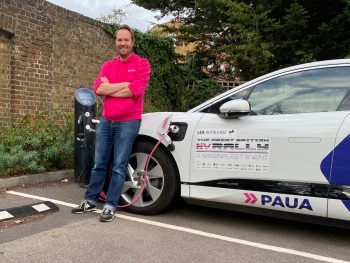Niall Riddell, CEO of EV fleet fuel card provider Paua, on the environmental cost of online deliveries.

Online deliveries are increasing
Whether it’s food shopping, clothes or gifts – the shift to buying online is accelerating. According to the Office of National Statistics (ONS), internet sales as a % of total retail sales have increased from 19.2% in 2019 to 30.7% in 2021. Back in 2010 it was only 7.3%.
Consumers are more concerned about emissions
However, as concerns about climate change grow, customers are increasingly aware of the carbon emissions involved in their online deliveries. A survey by Vanarama revealed that seven aout of 10 customers would consider shopping at a rival store if it offered eco-friendly delivery options. Companies are already responding to this. For example, some retailers such as Sainsburys and Ocado have started to encourage customers to pick a ‘green delivery slot’ where their drivers can combine several deliveries in one area. Amazon gives customers the option to have multiple items parcelled in one delivery and DPD makes customers aware that they could reduce the carbon footprint of their parcel through travelling on foot or bike to a local collection point.
The Vanarama survey claims that a typical parcel delivery involves 181g of CO2. And now the race is on between ethically minded companies to lower that – ideally to zero by shifting deliveries to electric.
For parcels to get greener – deliveries need to go electric
In 2019 Doug Parr, Chief Scientist and Policy Director at Greenpeace told the BBC: “We need to see delivery companies switch their entire fleet of vehicles to ones powered by clean energy – to be truly clean, these would need to be charged by renewable power rather than fossil fuel.”
It’s a view we agree with. Transport remains the highest emitter in the UK and fleet drivers cover a much higher mileage than private motorists. Electrifying fleets, including those involved in parcel deliveries is the quick win that will make the biggest and fastest contribution to CO2 reduction.
Moving deliveries to electric – challenges and opportunities
Fleet managers have many incentives to switch. The ban on the sale of new petrol and diesel vehicles in 2030 is drawing ever closer. Also, the number of clean air zones in the UK in which companies will have to pay a charge for polluting vehicles to enter is set to increase. Bradford and Bristol are both scheduled to start charging in autumn/winter 2022 and more cities are set to follow in 2023. And increasingly delivery firms are wanting to be seen as having a commitment to sustainability.
Some start-up companies have built their business around zero-emissions delivery. But for most delivery fleets, it’s a case of managing the transition from their diesel vehicles to electric ones.
If you’ve been running a conventional delivery fleet changing all at once isn’t the best strategy. Recruiting enthusiastic drivers and selecting easier routes is an excellent start. Companies can then see what is and isn’t working and build from there.
One of the current obstacles is that the demand for electric vehicles is currently exceeding supply. Another key issue that needs to be addressed is how the electric vans will be charged.
The importance of public charging for electric delivery vans
Not so long ago most commercial electric vehicles were either milk floats or fork-lift trucks, which were charged at their depots. But for larger electric fleets installing sufficient depot charging be costly. Some delivery drivers may be able to charge at home, but it raises the question of who should pay for the charger – them or the company? Figures indicate that 40% of drivers live in flats or terraced homes without access to off-street parking so home charging isn’t an option.
This means it’s essential for delivery vans to have easy access to public charging.
Whilst depot and home charging has been the mainstay to date, public charging is a crucial component of most fleets’ electrification strategy. It means fleets can run smaller battery sized vehicles and longer routes can be electrified and also that vehicles don’t have to return to the depot for charging, taking up part of the driver’s working day. Ultimately public charging can save time and money for fleets.
Overcoming public charging problems for delivery vans
In the UK we have over 80 charge point networks, which means drivers can end up needing many apps and cards to access chargers. This is annoying and time-consuming for private motorists but particularly problematic for delivery drivers. For every charge session the business will need a receipt to claim back the 20% VAT and acquiring a receipt from a charge point network can be extremely challenging, requiring multiple phone calls, emails and webforms, taking many hours to gather.
However, the Paua fleet fuel card is providing a solution to this problem. Paua is the largest independent business-focused roaming network in the UK, allowing business drivers to access over 20,000 charge point connectors and providing fleet managers with a single VAT compliant bill. Its network includes Connected Kerb, Osprey and ChargePlace Scotland.
Many fleet managers are eager to switch their fleets to electric. These vehicles will be on the road as soon as budgets and supply chain issues allow – and any obstacles to their smooth adoption need addressing now. That includes a comprehensive public charging network and the ability for fleets to find, charge and pay for charging in a simple and hassle-free manner.

